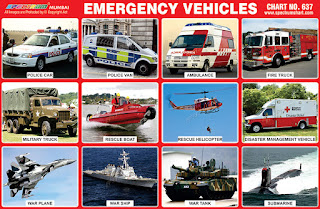 |
| Emergency Vehicles Chart |
Spectrum Chart - 637 : Emergency Vehicles
1. Police Car – A police car is a ground
vehicle used by police for transportation during patrols and to
enable them to respond to incidents. Typical uses of a police car
include transporting officers so they can reach the scene of an
incident quickly, transporting and temporarily detaining suspects in
the back seats. Police cars typically have rooftop flashing lights, a
siren and emblems or markings indicating that the vehicle is a police
car.
2. Police Van – A police van is a type
of vehicle operated by police forces. Police vans are usually
employed for the transportation of prisoners inside a specially
adapted cell in the vehicle or for the rapid transportation of a
number of officers to an incident. Police vans may have a flip down
wire shield across the windscreen, which helps prevent projectiles
from damaging the vehicle.
3. Ambulance - An ambulance is a type of
vehicle made to carry sick or injured people. Normally, ambulances go
to people in emergencies to take people to hospital. Ambulances
normally have emergency medical technicians and paramedics who work
on them. They are highly trained to provide emergency care and
treatment before reaching a hospital. The ambulance carries lots of
first aid supplies for bleeding, broken bones, car crashes, burns,
heart and breathing problems and lots of other medical emergencies.
4. Fire Truck – A fire truck is a
vehicle designed primarily for firefighting operations. The primary
purposes of a fire engine include transporting firefighters to an
incident scene, providing water with which to fight a fire and
carrying other equipment needed by the firefighters. A typical modern
vehicle will carry tools for a wide range of firefighting and rescue
tasks, with common equipment including ladders, a self-contained
breathing apparatus, ventilating equipment, first aid kits and
hydraulic rescue tools.
5. Military Truck – Military
trucks are wheeled motor vehicles designed for use by military
forces to transport cargo - including fuel, ammunition and other
vehicles. Military trucks are operational on varied terrains, from
coastal operations to high-altitude bases, from deserts to
snow-covered mountainous regions, at altitudes up to 5500 metres and
temperatures ranging from −35°C to 55°C. Military trucks are the
logistical backbone of the armed forces.
6. Rescue Boat – Rescue boats also known
as lifeboats are typically vessels manned by volunteers, intended for
quick dispatch, launch and transit to reach a ship or individuals in
trouble at sea. A rescue lifeboat is a boat rescue craft which is
used to attend a vessel in distress or its survivors, to rescue crew
and passengers. It can be hand pulled, sail powered or powered by an
engine. Lifeboats may be rigid, inflatable or rigid-inflatable
combination hulled vessels.
7. Rescue Helicopter – Rescue
helicopters are used as air ambulances for emergency medical
assistance in situations when an ambulance cannot easily or quickly
reach the scene or cannot transport the patient to a medical facility
in time. Helicopters are also used when patients need to be
transported between medical facilities. An air ambulance helicopter
is equipped to stabilise and provide limited medical treatment to a
patient while in flight. The use of helicopters as air ambulances is
often referred to as "MEDEVAC" and patients are referred to
as being "airlifted" or "medevaced".
8. Disaster Management Vehicle – An
disaster management vehicle is any vehicle that is designated and
authorized to respond to an emergency. These vehicles are usually
operated by designated agencies, often part of the government, but
also run by charities, non-governmental organisations and some
commercial companies. Often emergency vehicles are permitted by law
to break conventional road rules in order to reach their destinations
in the fastest possible time.
9. War Plane – War planes are designed
to destroy enemy equipment using their own aircraft ordnance. War
plane are normally developed and procured only by military forces.
Warplanes", are divided broadly into multi-role, fighters,
bombers and attackers, they are often equipped to attack with
anti-ship missiles and anti-submarine weapons.
10. War Ship – A warship is a naval ship
that is built and primarily intended for naval warfare. Warships are
designed to withstand damage and are usually faster and more
manoeuvrable than merchant ships. Warships usually belong to a navy.
11. War Tank – A tank is an armoured
fighting vehicle designed for front-line combat, with heavy
firepower, strong armour and tracks providing good battlefield
manoeuvrability. A tank is covered in thick armour to protect it
from enemy weapons. Tanks have tracks that wrap around its wheels to
spread out its weight and let it cross rough ground. Most tanks have
a powerful gun and one or more machine guns.
12. Submarine – A submarine is a
watercraft capable of independent operation underwater. The term most
commonly refers to a large, crewed, autonomous vessel. Most large
modern military submarines are powered by nuclear reactors. These
submarines often have a system which can get air from the seawater.
These two things allow them to stay under water for long periods of
time. Their most important uses are attacking ships or launching
missiles. These include cruise missiles and nuclear missiles.

No comments:
Post a Comment